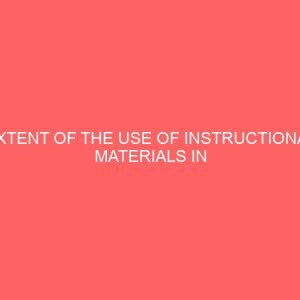Description
CHAPTER ONE INTRODUCTION
Background of the Study
There is no single universal definition of Social Studies because the subject is defined according to the need of each society, which adopts it as a programme of study in schools and colleges. However, the Committee on Primary School Social Studies programme in Nigeria defines Social Studies as those common learning of man?s interaction with his social and physical environment, adding that it is not only a study, but a way of life, of how man influences, and is influenced by his physical, social, political, economic, psychological and cultural environment (Aina, Adeyoyin, Obilo. and Ahmadu, 1982)
Similarly Olaniyan (1998) emphasized that Social Studies is a programme which a society uses to instill in students the knowledge, skills, attitudes and actions it considers important concerning the relationship which human beings have with each other, their world and themselves. Bearing in mind the concept of Social Studies as an integrated discipline, the objectives are clearly stated in the National Policy on Education (FRN, 2004).
The primary concerns of the subject are encouragement of the awareness of the world in the child, inculcation and development of appropriate knowledge, skills, attitudes, values and social activities concerning relationships in people; to enable them find solutions to social problems in their surroundings and to develop positive
attitudes towards our fellow men in society.
Social science as the teaching and learning of individual subjects such as History, Geography, Government, etc. has finally given way to the conception in Social Studies as an integrated subject This came about in fact with the adoption in 1975 of the Integrated Social Studies Syllabuses developed by the National Educational Research Council fortheprimary schools and Teacher Training Colleges throughout the country at the on-set of the Federal Government University Free Primary Education (UPE). Similarly, the Integrated Social Studies Syllabus currently being used in the lower forms of secondary schools in the country as well as the one for the 3-3 Secondary School system of the New Education Policy was prepared by the Comparative Education Study and Adaptation Centre (CESAC), University of Lagos (Ogunsanya, 1984). Social Studies is a subject which deals principally with how human beings interact with one another and with the environment. The Committee on Social Studies singled it out as one major area of study through which national objectives on education in Nigeria can be achieved. Specifically, the Committee spelled out the underlisted objectives for teaching Social Studies in the primary and secondary school levels of the Nigerian education system:
1. To encourage the development of social responsibility towards other children, adult and the world.
2. To encourage the development of values, attitudes, skills and understanding necessary to live and function in society.
3. To create an awareness and an understanding of the evolving social and physical environment as a whole, its natural, man-made, cultural and spiritual resources together with national use and conservation of these resources for development
4. To ensure the acquisition of that relevant knowledge which is an essential prerequisite for personal development, as well as a positive personal contribution to the betterment of mankind.
5. To develop in children a positive attitude to citizenship and a desire to make a personal positive contribution to the creation of a progressive and united Nigeria.
6. To develop in the children the ability to think critically and reflectively and come to an independent conclusion.
7. To promise an understanding of the social problems facing the Nigerian society and a desire to find solutions to them (Ogunsanya, 1984; Obeta, 1996; and Enem, 2002).
The objectives of Social Studies Education in Nigeria, as stated above, show that the subj ect was introduced into the school curriculum to, among other things, get rid of certain social vices plaguing the Nigerian society. Such vices include tribalism, ethnicity, nepotism, political instability, mass poverty, immorality, drug abuse, disrespect for elders and so on. Social Studies also meet the needs of the society in the areas of social and intellectual skills as well as attitudes and values. The subject
is also concerned with acquiring the desirable information in order to be able to achieve meaningful development in all sectors of the economy (Ogunsanya, 1984). The summary of our discussion clearly indicates that Social Studies education is central to nation building. Our leaders and policy-makers need to acquire desirable social and intellectual skills, as well as positive attitudes and values that will enable them to make positive contributions to the process of nation building. They need to appreciate the economic and socio-political diversities of Nigeria, and the need for unity, tolerance and inter-dependence among the various component units of Nigeria.
To achieve the above objectives, the subject must be properly taught in our schools. One major characteristic of good teaching of Social Studies is the ability to inculcate in students a spirit of curiosity and self-instruction (Enem, 2002). A great deal has been discovered about what attracts the interest of children, holds their attention and fosters that natural curiosity. Enem (2002) opined that nothing attracts learners? attention faster than the use of relevant resource materials. For example, bright, contrasting colours seem to stimulate them as well as seize their attention. Similarly, interesting shapes and objects are also very important, especially at the lower levels of our education system.
The use of adequate and relevant resource materials has numerous advantages. For example, it facilitates teaching and learning, and makes learning faster and more permanent. Teachers do not need to expend a great deal of energy or time in giving out much information or much guidance. Rather, he guides the pupils to find out or
discover things on their own. For instance, if a picture of a boy eating a banana is shown to the class and the caption of the picture is: ?This boy is eating his banana?, the teacher could ask his class ?Where do you think the banana came from??. A question such as this forces the pupils to look at the picture critically and study it for contextual clues. Where is the boy standing? (Market, Farm or School?) What has he been doing? What are the commonest ways through which boys obtain banana?
In Social Studies, resource materials encourage the pupils to think critically and reflectively about their lives and their surroundings. This helps to build up the students? self esteem and confidence. In addition, resource materials arouse the students? interest on the subject. We all know that interest motivates learning. Social Studies teachers should make effective utilization of instructional materials in teaching because, they make teaching more meaningful, interesting and more permanent. The extent teachers make use of instructional materials in the teaching of Social Studies is not known. Therefore, the need arises for a determination of the extent teachers use instructional materials in teaching Social Studies at the Junior Secondary Schools (JSS).
Statement of the Problem
Experience shows that many teachers of Social Studies have been teaching for years without using teaching resources and without encouragement by the government. Abdullahi (1982) pointed to poor method of teaching as one of the
major factors that cause the poor performance of students in science subjects. Obi (1992) asserted that teachers have resorted to verbalizing their lessons relying heavily on the use of chalkboard, otherwise called ?talk chalk? method of teaching. Those views are in agreement with Mayer?s (1988) that teaching in the African context continues to be dominated by talk and chalk method. This poor method of teaching could be one of the reasons of underachievement of students in Social Studies.
There have been many researches directed at evaluating the extent of the use of instructional media in teaching Social Studies. For instance, researchers like Onyekwelu (1995), investigated Availability and Use of Media in Teaching History in Secondary Schools in Anam bra State. Angwe and Idogbe (2004) investigated the Availability and Use of Biology Lab Equipment in the Teaching of Biology in Secondary Schools in Vandeiky a L.G. A. of Benue State. Onuoha (1999) investigated on Students? Perception of Television Religious Programmes in Imo State. Eze and Iloh (1999) researched on Resources Used in Teaching Christian Religious Knowledge in the Junior Secondary School at Nsukka Urban. Agu Emeka (1995) investigated the Status of Media in teaching and learning of Economics in Enugu- North L.G.A. Ukachukwu (1998) researched on Effect of Overlay Technique on Secondary School Students? Achievement in Biology. Using good diagrams, Winn (1982) Projected and Non-projected media; Nwizu (1992), Multimedia Approach; Obi (1992), Different Modes of Picture Presentation (Ofoegbu, 1992).
The problem of the study therefore, is the extent of the use of instructional
materials in the teaching of Social Studies in Nsukka Education Zone.
Purpose of the Study
The major purpose of the study is to determine the availability and the extent of use of instructional materials in teaching Social Studies in JSS in Nsukka Education Zone. In order to achieve this major purpose, certain specific investigations will be undertaken. These include:
1. To determine the type of instructional materials available for use in
schools in Nsukka Education Zone in teaching Social Studies.
2. To establish the extent of use of the available instructional materials for Social Studies lessons.
3. To identity methods used in teaching Social Studies in the schools.
Significance of the Study
The findings of this study will be beneficial to the Social Studies teachers in Nsukka Education Zone. It will provide information on the available media which they can use. It will also be beneficial to the curriculum planners. It will help curriculum planners to determin e the type of instructional materials available for use, establish the extent of use and identify methods used in teaching Social Studies in the schools. This is with a view to determining instructional materials to be included in the curriculum of the JSS Social Studies and that of the Teacher Training Colleges.
It may provide the justification for emphasizing the teaching of improvisation to trainee teachers in the Colleges.
The results of the study will provide information on the available modes for Social Studies instruction. This will be very useful to ministries of education and policy makers by providing them with data on the materials that needed to be acquired for effective Social Studies instruction.
The extent of use of these materials will enable the Post Primary School Board to organize workshops, conferences and seminar on the production and use of instructional materials to facilitate the learning of Social Studies.
The results of the study will provide information that may be useful for research in this area.
Scope of the Study
The study is limited to the availability and use of instructional materials in teaching Social Studies in JSS in Nsukka Education Zone. It also includes a determination of the teaching methods teachers adopt in Social Studies instruction.
Research Questions
The following research questions have been formulated to guide the study:
1. What instructional materials are available in schools for Social Studies
instruction in Nsulika Education Zone?
To what extent are instructional materials used in Social Studies instruction?
What different methods are used in Social Studies lessons?







